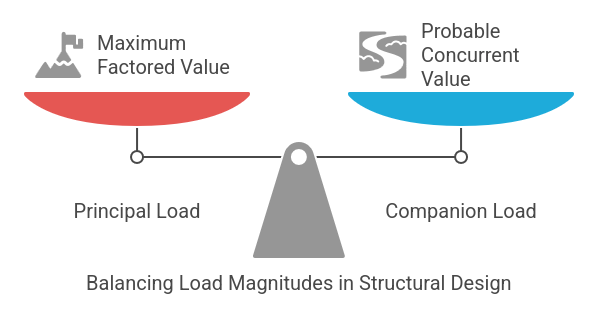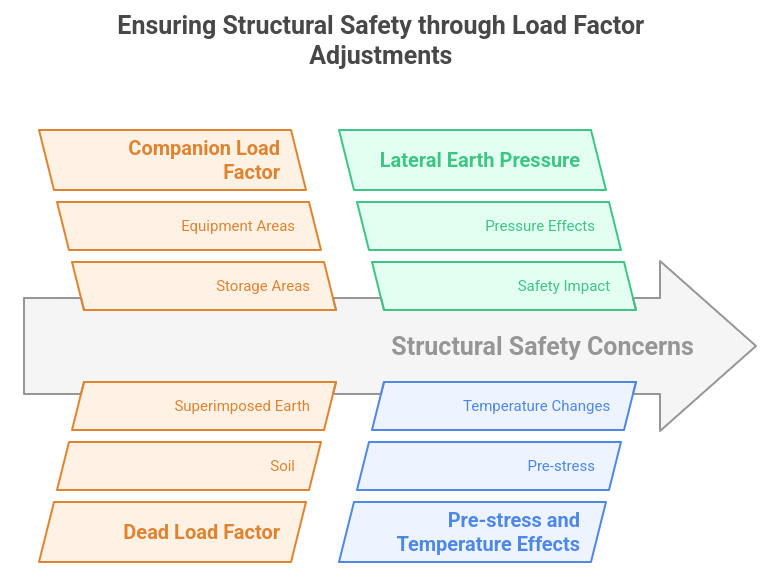Mastering NBC 2020 Load Combinations
- Start by classifying principal vs. companion actions—Table 4.1.3.2 only works if you pick the controlling load correctly.
- Use the generalized combo format to script your software, then layer on the special cases for fire, uplift, and overturning.
- Keep SLS combinations separate from ULS; the commentary’s shorthand helps avoid over-strengthening for serviceability checks.

On this page
Navigating load combinations can sometimes feel like a complex dance. Get one step wrong, and the whole routine can fall apart. The National Building Code of Canada (NBC) 2020, specifically Article 4.1.3.2. and its associated tables, lays out the choreography for ensuring our structures are safe under various loading scenarios. Whether you’re getting to grips with principal and companion loads or double-checking a tricky overturning case, a solid understanding here is non-negotiable.
Here we’ll look at the key principles of NBC 2020 load combinations, focusing on how to apply them practically. We’ll touch on the “companion action principle,” how to use Tables 4.1.3.2.-A and -B, and what to do when your situation isn’t explicitly covered.
Limit States Design and the Companion Action Principle
At its heart, structural design in Canada is about ensuring factored resistance is greater than or equal to the effect of factored loads. The NBC 2020 load combinations are built on the Limit States Design philosophy.

A key concept underpinning these combinations is the “companion action principle” (explained in NBC2020-Commentary Commentary A, Para 29). The gist is:
- Loads are categorized: Permanent (Dead load, D), Variable (Live load L, Snow S, Wind W), and Rare (Earthquake E, Fire).
- It’s unlikely that the absolute maximum of all variable and rare loads will hit your structure simultaneously.
- So, we design for one load acting at its principal (maximum factored) value, while other relevant loads act at their companion (probable concurrent) values.
This approach, recommended by ISO 2394, gives us a more realistic yet safe way to combine loads.
Decoding the Tables: 4.1.3.2.-A and 4.1.3.2.-B
These tables are your bread and butter for most ULS load combinations:
- Table 4.1.3.2.-A: For load cases without crane loads.
- Table 4.1.3.2.-B: For load cases with crane loads.
Here’s how to read Table 4.1.3.2.-A (NBC2020):
- Case 1: 1.4D
- Simple enough: 1.4 times the Dead Load. The classic starting point.
- Case 2: (1.25D or 0.9D) + 1.5L + (1.0S or 0.4W)
- Here, Live Load (L) is the principal load with a factor of 1.5.
- Snow (S) and Wind (W) are companion loads, with factors of 1.0 and 0.4 respectively. You check which companion load (S or W) creates the more critical effect when combined with 1.5L. You don’t add both 1.0S and 0.4W together in this specific instance within Case 2; it’s one or the other.
- The 0.9D factor is used when dead load resists the applied loads (e.g., for overturning or uplift checks – more on that later).
- Case 3: (1.25D or 0.9D) + 1.5S + (1.0L or 0.4W)
- Similar logic, but Snow (S) is now the principal load (1.5S).
- Live Load (L) and Wind (W) are companions.
- Case 4: (1.25D or 0.9D) + 1.4W + (0.5L or 0.5S)
- Wind (W) is the principal load (1.4W).
- Live Load (L) and Snow (S) are companions.
- Case 5: (1.0D or 0.9D) + 1.0E + 0.5L + 0.25S
- Earthquake (E) is the principal load (1.0E).
- Live Load (L) and Snow (S) are companions with reduced factors. The 1.0D factor here is specifically for earthquake load combinations (when dead load is not counteracting).
Design reminder: Each ‘Case’ in the table represents a distinct scenario. You need to evaluate all applicable cases to find which one produces the most critical effect (highest force, moment, stress, etc.) for each structural element you’re designing.
Important Notes for Tables 4.1.3.2.-A and -B (from NBC2020):
- The notes below these tables are critical! For instance, Note (3) for Table A mentions increasing the companion load factor for L to 1.0 (from 0.5) in storage areas, equipment areas, and service rooms for Cases 2, 3, and 5.
- For soil, superimposed earth, etc., the dead load factor can be 1.5 (Note (3) to D in Table A).
- Lateral earth pressure (H), pre-stress (P), and effects of temperature changes/settlement (T) must be included with their own factors if they affect structural safety (Article 4.1.3.2.(4)).

Generalized Load Combinations
What if your situation isn’t neatly covered? The Structural Commentaries (NBC2020-Commentary Commentary A, Paras 29-31 and Table A-3) provide guidance on generalized load combinations:
- For Variable Loads (Para 30): \(\Sigma\alpha_{G_{i}}G_{i}+\alpha_{Q_{1}}Q_{l}+\Sigma\alpha_{CQ_{i}}Q_{i}\) Where \(G_i\) are permanent loads, \(Q_1\) is the principal variable load, and \(Q_i\) are other variable (companion) loads.
- For Rare Loads (Para 31): \(\Sigma\alpha_{G_{i}}G_{i}+A+\Sigma\alpha_{Q_{i}}Q_{i}\) Where \(A\) is the rare load (like Earthquake E, or other accidental loads). Table A-3 in the commentaries gives the \(\alpha\) factors for these. For instance, for rare loads like E, the factor is 1.0. Companion live load (L) typically takes 0.5, and companion snow (S) takes 0.25.
Special Cases
The NBC and its commentaries also address specific scenarios:
1. Overturning, Uplift, Sliding, and Stress Reversal:
- This is where the 0.9D (or sometimes 1.0D for seismic combinations) factor is crucial (NBC Article 4.1.3.2.(5) and NBC2020-Commentary Commentary A, Para 40).
- You’re using the minimum expected dead load to ensure stability against forces trying to lift or overturn the structure.
- Counteracting variable loads are taken as zero in these checks within the standard combinations.
Watch for: When checking overturning, ensure your resisting dead load acts through the center of gravity of the deflected structure, especially for flexible structures or retaining walls (NBC2020-Commentary Commentary A, Para 41).
2. Fire Resistance:
- Fire is a rare event, so NBC allows for considering modified load combinations, but this requires expert knowledge and potentially an alternative solution approach (NBC2020-Commentary Commentary A, Paras 46-49).
- An example combination given is: \(D + T_S + (\alpha L \text{ or } 0.25S)\), where \(\alpha\) is 1.0 for storage/equipment areas and 0.5 for others. \(T_S\) is the short-term thermal effect.
- Always check relevant material standards (CSA S16, A23.3, O86) as they might have specific stipulations for fire load combinations.
3. Industrial Buildings & Cranes:

- Table 4.1.3.2.-B is your go-to for crane loads. It considers crane live loads (C), self-weight of cranes (\(C_d\)), and bumper impact (\(C_7)\).
- For unusual loads in industrial settings not covered by Part 4, you might need to look at specialized standards. CSA S16, for instance, is referenced for crane operations (NBC2020-Commentary Commentary A, Para 45).
- Note A-4.1.3.2.(2) (NBC2020) also points to the CISC/ICCA “Crane-Supporting Steel Structures: Design Guide” for detailed guidance.
Wrapping Up
Load combinations are a cornerstone of safe structural design. While NBC 2020 provides a comprehensive framework, the onus is on us, the engineers, to apply these principles correctly and diligently.
- Always start with Tables 4.1.3.2.-A and -B.
- Don’t forget the notes! They contain crucial modifications.
- Understand the companion action principle.
- Be extra careful with overturning and stability checks.
- Consult the Structural Commentaries and material standards for special cases or when in doubt.
Disclaimer: This blog post is for informational purposes only and should not be taken as specific engineering advice. Always consult the latest edition of the National Building Code of Canada and relevant CSA standards for your projects.
Next up for you
Standards, Design Principles
Nailing Importance Categories in NBC 2020
Understand NBC 2020 Importance Categories in Canada. Learn "post-disaster" building criteria, AHJ roles, and how Importance Factors …
Keep reading →Standards, Design Principles, Industry Insights, Practical Applications
Part 4's Leap vs. Part 9's Sticking Point
A deep dive into the NBCC 2020 seismic updates, comparing Part 4's evolution with CanadaSHM6 and Part 9's lag, and what it means for your …
Keep reading →Standards, Design Principles, Industry Insights, Professional Development
Tracing the Evolution of NBC Structural Design
A look back at how structural design in the National Building Code of Canada has evolved. Understanding the shift to Limit States Design …
Keep reading →Was this helpful?
Tell us what to cover next or request a deeper dive—every response goes straight to Arun.